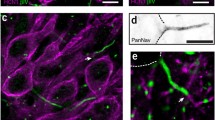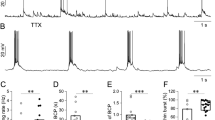Metabotropic serotonin 5-HT1 receptors in cerebral neurons have a role in regulating such emotional states in humans as aggression, fear, and alcohol addiction. Activation of presynaptic 5-HT1B receptors leads to suppression of Ca2+ influx via potential-dependent calcium channels in certain neurons. Ca2+ influx into cells was measured in terms of the increase in the cytosolic calcium ion concentration in response to depolarization induced by addition of 35 mM KCl. An image analysis system showed that Ca2+ responses to depolarization of cultured hippocampal cells differed in terms of shape, rate, and amplitude in different neuron populations. 5-HT1B receptor agonists produced minor suppression of the activity of potential-dependent calcium channels in 86 ± 3% of neurons. Two minor cell populations (5–8% of cells each) were seen, which differed strongly in terms of the extent of desensitization of the Ca2+ signal. The calcium signal of one cell population responded to depolarization with a characteristic delay and a high rate of quenching. 5-HT1B receptor agonists produced powerful inhibition of the amplitude of the Ca2+ response to KCl only in this population. The calcium signal of the second population of cells was characterized by the absence of densensitization. 5-HT1B receptor agonists produced minor increases in the amplitude of the calcium response to depolarization in this population of neurons. Thus, these studies demonstrated differences in the serotonin 5-HT1B receptor sensitivities of potential-dependent calcium channels in different neuron populations.
Similar content being viewed by others
References
A. V. Kononov, N. V. Bal’, and V. P. Zinchenko, “Variability in the calcium responses of hippocampal neurons to glutamate receptor agonists,” Biol. Membrany, 28, No. 2, 127–136 (2011).
A. V. Kononov, N. V. Bal’, and V. P. Zinchenko, “Regulation of spontaneous synchronous Ca2+ oscillations in hippocampal neurons by GABAergic neurons containing kainate receptors without desensitization,” Biol. Membrany, 29, No. 1–2, 133–138 (2012).
R. M. de Almeida and K. A. Miczek, “Aggression escalated by social instigation or by discontinuation of reinforcement (‘frustration’) in mice: inhibition by anpirtoline: a 5-HT1B receptor agonist,” Neuropsychopharmacology, 27, No. 2, 171–181 (2002).
U. Boschert, D. A. Amara, L. Segu, and R. Hen, “The mouse 5-hydroxytryptamine 1B receptor is localized predominantly on axon terminals,” Neuroscience, 58, 167–182 (1994).
M. E. Castro, J. Pascual, T. Ramón, et al., “5-HT1B receptor binding in degenerative movement disorders,” Brain Res., 790, No. 1–2, 323–328 (1998).
M. S. Clark, T. J. Sexton, M. McClain, et al., “Overexpression of 5-HT1B receptor in dorsal raphe nucleus using herpes simplex virus gene transfer increases anxiety behavior after inescapable stress,” J. Neurosci., 22, No. 11, 4550–4562 (2002).
T. Collin, M. Chat, M. G. Lucas, et al., “Developmental changes in parvalbumin regulate presynaptic Ca2+ signalling,” J. Neurosci., 25, No. 1, 96–107 (2005).
B. Grimaldi, M. P. Fillion, A. Bonnin, et al., “Immunocytochemical localization of neurons expression 5-HT-moduline in the mouse brain,” Neuropharmacology, 36, No. 8, 1079–1087 (1997).
H. Hayashi and H. Miyata, “Fluorescence imaging of intracellular Ca2+,” J. Pharmacol. Toxicol. Meth., 31, No. 1, 1–10 (1994).
D. Hoyer, J. P. Hannon, and G. R. Martin, “Molecular, pharmacological and functional diversity of 5-HT receptors,” Pharmacol. Biochem. Behav., 71, No. 4, 533–554 (2002).
T. Klausberger, P. J. Magill, L. F. Marton, et al., “Brain-state- and cell-type specific firing of hippocampal interneurons in vivo,” Nature, 421, 844–848 (2003).
T. Kosaka, H. Katsumaru, K. Hama, et al., “GABAergic neurons containing the Ca2+-binding protein parvalbumin in the rat hippocampus and dentate gyrus,” Brain Res., 419, No. 1–2, 119–130 (1987).
S. H. Lee and I. Soltesz, “Requirement for CB1 but not GABAB receptors in the cholecystokinin mediated inhibition of GABA release from cholecystokinin expressing basket cells,” J. Physiol., 589, No. 4, 891–902 (2011).
H. Mizutani, T. Horri, and T. Takahashi, “5-HT1B receptor-mediated presynaptic inhibition at the calyx of Held of immature rats,” Eur. J. Neurosci., 24, No. 7, 1946–1954 (2006).
M. Muller, F. Felmy, B. Schwaller, and R. Schneggenburger, “Parvalbumin is a mobile presynaptic Ca2+ buffer in the calyx of Held that accelerates the decay of Ca2+ and short-term facilitation,” J. Neurosci., 27, No. 9, 2261–2271 (2007).
C. Nitsch, A. Scotti, A. Swommacal, and G. Kalt, “GABAergic hippocampal neurons resistant to ischemia-induced neuronal death contain the Ca2+-binding protein parvalbumin,” Neurosci. Lett., 105, No. 3, 263–268 (1989).
K. Nakamura, T. Kikusui, Y. Takeuchi, and Y. Mori, “Changes in social instigation- and food restriction-induced aggressive behaviors and hippocampal 5-HT1B mRNA receptor expression in male mice form early weaning,” Behav. Brain Res., 187, No. 2, 442–448 (2008).
B. Oliviera and R. van Oorschota, “5-HT1B receptors and aggression,” Eur. J. Pharmacol., 526, No. 1–3, 207–217 (2005).
N. L. Rochefort, H. Jia, and A. Konnerth, “Calcium imaging in the living brain: prospects for molecular medicine,” Trends Mol. Med., 14, No. 9, 389–399 (2008).
F. Saudou, D. A. Amara, A. Dierich, et al., “Enhanced aggressive behavior in mice lacking 5-HT1B receptor,” Science, 265, 1875–1878 (1994).
H. Schmidt, K. M. Stiefel, P. Racay, et al., “Mutational analysis of dendritic Ca2+ kinetics in rodent Purkinje cells: role of parvalbumin and calbindin-D28K,” J. Physiol., 551, 13–32 (2003).
P. Somogyi, T. F. Freund, and A. Cowey, “The axo-axonic interneuron in the cerebral cortex of the rat, cat, and monkey,” Neuroscience, 7, 2577–2607 (1982).
V. Volman, M. M. Behrens, and T. J. Sejnowski, “Downregulation of parvalbumin at cortical GABA synapses reduces network gamma oscillatory activity,” J. Neurosci., 31, No. 49, 18,137–18,148 (2011).
J. Winterer, A. V. Stempel, T. Dugladze, et al., “Cell-type-specific modulation of feedback inhibition by serotonin in the hippocampus,” J. Neurosci., 31, No. 23, 8464–8475 (2011).
V. K. Yadav, J. H. Ryu, N. Suda, et al., “Lrp5 controls bone formation by inhibiting serotonin synthesis in the duodenum,” Cell, 135, No. 5, 825–837 (2008).
Author information
Authors and Affiliations
Corresponding author
Additional information
Translated from Rossiiskii Fiziologicheskii Zhurnal imeni I. M. Sechenova, Vol. 99, No. 1, pp. 63–72, January, 2013.
Rights and permissions
About this article
Cite this article
Kononov, A.V., Ivanov, S.V. & Zinchenko, V.P. Regulation of Potential-Dependent Ca2+ Channels by Serotonin 5-HT1B Receptors in Different Populations of Hippocampal Neurons. Neurosci Behav Physi 44, 989–994 (2014). https://doi.org/10.1007/s11055-014-0014-3
Received:
Published:
Issue Date:
DOI: https://doi.org/10.1007/s11055-014-0014-3




